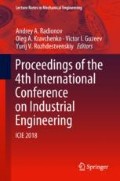Abstract
The article presents the characteristics of polymer composites processing, in particular, the wear process of the cutting tools. It is revealed that composite materials are difficult for machine cutting and require to apply a high-strength tool material and selection of optimal cutting mode. The important task is to reduce the cutting tool wear speed. To solve the problem, the experiment with a variation of the cutting mode was conducted, and the results showed that the tool wears faster at the high cutting speed and cutting depth. With the cutting speed increase, the intensity of the growth of the wear chamfer increases significantly, and therefore, when setting the cutting conditions, one should be guided by a rational combination of the operability of the cutting tool, the quality of the machined surface, and the processing capacity. These studies have also allowed to establish that the uneven wear process is uneven throughout the length of the cutting edge due to the layer structure of the composite.
Access this chapter
Tax calculation will be finalised at checkout
Purchases are for personal use only
References
Grigoriev SN, Krasnovskii AN, Kvachev KV (2014) Investigation of impregnation fibrous materials in pultrusion process of polymer composite materials. Int Polym Sci Technol 7:59–62
Gallant FM, Bruck HA, Prickett SE, Cesarec M (2006) Graded polymer composites using twin-screw extrusion: a combinatorial approach to developing new energetic materials. Compos A Appl Sci Manuf 6:957–969. https://doi.org/10.1016/j.compositesa.2005.03.025
Dhand V, Mittal G, Rhee KY, Park S-J, Hui D (2015) A short review on basalt fiber reinforced polymer composites. Compos B Eng 73:166–180. https://doi.org/10.1016/j.compositesb.2014.12.011
Gorokhovsky AV, Escalante-Garcia JI, Gashnikova GYu, Nikulina LP, Artemenko SE (2005) Composite materials based on wastes of flat glass processing. Waste Manag 7:733–736. https://doi.org/10.1016/j.wasman.2004.11.007
Matis IG (1991) Methods and means of inspecting the quality of composite materials. Russ J Nondestr Test 4:277–285
Bakulin VN, Larin AA, Reznichenkod VI (2015) Improving the quality of manufacture of polymer-composite products using computed tomography as a nondestructive-testing method. J Eng Phys Thermophys 2:556–560
Yuanyushkin AS, Rychkov DA, Lobanov DV (2014) Surface quality of the fiberglass composite material after milling. Appl Mech Mater 682:183–187. https://doi.org/10.4028/www.scientific.net/AMM.682.183
Bokhoeva LA, Rogov VE, Chermoshentseva AS, Lobanov DV (2016) Stability and process of destruction of compressed plate of layered composite materials with defects. IOP Conf Ser Mater Sci Eng 142:012077. https://doi.org/10.1088/1757-899X/142/1/012077
Lemma E, Chen L, Siores E, Wang J (2002) Study of cutting fiber-reinforced composites by using abrasive water-jet with cutting head oscillation. Compos Struct 1–4:297–303. https://doi.org/10.1016/S0263-8223(02)00097-1
Zaykin YA, Koztaeva UP (2000) Radiation-induced processes and internal friction in polymer-based composite materials. Radiat Phys Chem 4:387–395. https://doi.org/10.1016/S0969-806X(99)00517-4
Rychkov DA, Yanyushkin AS (2016) The methodology of calculation of forces when machining composite materials. IOP Conf Ser Mater Sci Eng 142:012088. https://doi.org/10.1088/1757-899X/142/1/012088
Fomin VN, Malyukova EB, Berlin AA (2004) Criteria for optimization of processing and fabrication of polymer composite materials. Dokl Chem 4–6:39–41. https://doi.org/10.1023/B:DOCH.0000017274.33223.c8
Yanyushkin AS, Rychkov DA, Lobanov DV (2016) Rationalization of polymer composite materials processing by improving production efficiency. Procedia Eng 150:942–947. https://doi.org/10.1016/j.proeng.2016.07.067
Bailleul JL, Sobotka V, Delaunay D, Jarny Y (2003) Inverse algorithm for optimal processing of composite materials. Compos A Appl Sci Manuf 8:695–708. https://doi.org/10.1016/S1359-835X(03)00141-6
Lobanov DV, Yanyushkin AS, Rychkov DA, Petrov NP (2011) Optimal organization of tools for machining composites. Russ Eng Res 2:156–157. https://doi.org/10.3103/S1068798X11020146
Yanyushkin AS, Rychkov DA (2017) The process of composite materials machining cutting tools profiling. Procedia Eng 206:944–949. https://doi.org/10.1016/j.proeng.2017.10.576
Popov V, Rychkov D, Arkhipov P (2017) Defects in diamonds as the basic adhesion grinding. MATEC Web Conf 129:01003. https://doi.org/10.1051/matecconf/201712901003
Popov V, Arkhipov P, Rychkov D (2017) Adhesive wear mechanism under combined electric diamond grinding. MATEC Web Conf 129:01002. https://doi.org/10.1051/matecconf/201712901002
Lobanov DV, Arhipov PV, Yanyushkin AS, Skeeba VYu (2017) Physical-chemical processes of diamond grinding. IOP Conf Ser Earth Environ Sci 87:082029. https://doi.org/10.1088/1755-1315/87/8/082029
Lobanov DV, Arkhipov PV, Yanyushkin AS, Skeeba VYu (2017) The research into the effect of conditions of combined electric powered diamond processing on cutting power. Key Eng Mater 736:81–85. https://doi.org/10.4028/www.scientific.net/kem.736.81
Yanyushkin AS, Lobanov DV, Arkhipov PV (2015) Research of influence of electric conditions of the combined electro-diamond machining on quality of grinding of hard alloys. IOP Conf Ser Mater Sci Eng 6:012051. https://doi.org/10.1088/1757-899X/91/1/012051
Lobanov DV, Arkhipov PV, Yanyushkin AS, Skeeba VYu (2016) Research of influence electric conditions combined electro-diamond processing by on specific consumption of wheel. IOP Conf Ser Mater Sci Eng 142:012081. https://doi.org/10.1088/1757-899x/142/1/012081
Author information
Authors and Affiliations
Corresponding author
Editor information
Editors and Affiliations
Rights and permissions
Copyright information
© 2019 Springer Nature Switzerland AG
About this paper
Cite this paper
Rychkov, D.A., Yanyushkin, A.S., Popov, V.Y. (2019). Specificity of Cutting Tool Wear in Processing of Polymer Composite Materials. In: Radionov, A., Kravchenko, O., Guzeev, V., Rozhdestvenskiy, Y. (eds) Proceedings of the 4th International Conference on Industrial Engineering. ICIE 2018. Lecture Notes in Mechanical Engineering. Springer, Cham. https://doi.org/10.1007/978-3-319-95630-5_127
Download citation
DOI: https://doi.org/10.1007/978-3-319-95630-5_127
Published:
Publisher Name: Springer, Cham
Print ISBN: 978-3-319-95629-9
Online ISBN: 978-3-319-95630-5
eBook Packages: EngineeringEngineering (R0)

